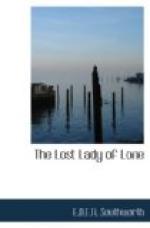The duke wrote again, and implored him to choose one of the learned professions, saying that it was not yet too late for him to enter upon the study of one.
The hopeful son replied that he was not good enough for divinity, bad enough for law, or wise enough for medicine; that, therefore, he was unsuited to honor either of the learned professions; and begged his guardian to disturb himself no longer on the subject of his ward’s future.
Then the duke let him alone, having, in fact, troubles enough of his own to occupy him—a life of superficial splendor, backed by a condition of hopeless indebtedness.
We have already, in the earlier portions of this story, described the short, glorious, delusive reign of the Herewards at Lone, and the culminating glory and ruin of the royal visit, so immediately to be followed by the great crash, when the magnificent estate, with all its splendid appointments, was sold under the hammer, and purchased by the wealthy banker and city knight, Sir Lemuel Levison. We have told how the noble son—the young Marquis of Arondelle—sacrificed all his life-interest in the entailed estate, to save his father, and how vain that sacrifice proved. We have told how the duchess died of humiliation and grief, and how the duke and his son went into social exile, until recalled by the romantic love of Salome Levison, who wished to bestow her hand and her magnificent inheritance upon the disinherited heir of Lone.
We have now brought the story of John Scott up to the night of the banker’s murder, and his own unintentional share in the tragedy.
At the time of the projected marriage between the Marquis of Arondelle and the heiress of Lone, John Scott was deeply sunk in debt, and badly in want of money.
The capital given him by his father had been so tied up by the donor that nothing but the interest could be touched by the improvident recipient. It had, in fact, been given to Sir Lemuel Levison in trust for John Scott, with directions to invest it to the best advantage for his benefit.
This duty the banker had most conscientiously performed by investing the money in a mining enterprise, supposed to be perfectly secure and to pay a high interest. This investment continued good for years, affording John Scott a very liberal income; but as John Scott would probably have exceeded any income, however large, that he might have possessed, so of course he exceeded this one and got into debt, which accumulated year after year, until at length he felt himself forced to ask his trustee to sell out a part of his stock in the mining company to liquidate his liabilities.
This the banker politely but firmly refused to do, representing to the young spendthrift that his duties as a trustee forbade him to squander the capital of his client, and that he had been made trustee for the very purpose of preserving it.
The obstinacy of the banker enraged the young man, who protested that it was unbearable to a man of twenty-five years of age to be in leading-strings to a trustee, as if he were an infant of five years old.




